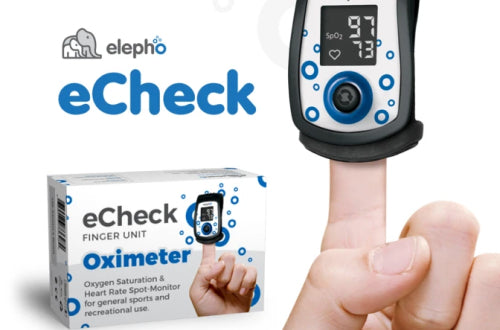Ever heard of an oximeter, sometimes referred to as a finger pulse oximeter? Most folks until recently only experienced using or seeing a pulse oximeter if you've had one clipped to your finger during a trip the ER or while in the hospital. If you have a lung or heart condition you may have periodically used one at home to monitor your condition under recommendation of your medical practitioner.
Regardless of your past familiarity with oximeters you may have noticed recently that pulse oximeters are popping up in the news and your social feeds, in conversation with friends and family and being promoted by your local drug store as a device recommended to have in your bathroom cabinet alongside your infra-red (IR) thermometer. As the cooler fall and winter month approach no doubt you’ll see more attention to this device as a ‘must’ to maintain your wellness and health especially this year as we enter the flu and winter virus season.
- What is a finger pulse oximeter? So what is a pulse oximeter and why should you consider purchasing one for home use? The oximeter (called a finger pulse oximeter since it works when placed on your finger) is a small, lightweight device used to monitor the amount of oxygen carried in blood flowing in your body. It’s a noninvasive tool (no pricks or needles) and it attaches painlessly to your fingertip and when turned on it sends two wavelengths of light into the finger to measure your pulse rate (also known as heart rate) and how much oxygen is in your blood system at that time (also known as blood oxygen saturation). These 2 measurements can quickly and easily give the user an indication of their overall wellness, especially with breathing and ability to function normally.
- How does a Pulse Oximeter work? For those interested in a more technical explanation, the oximeter uses two frequencies of light – red and infrared – to determine the percentage of hemoglobin in the blood that is saturated with oxygen, otherwise known as your oxygen saturation level (O2 sat level). When you breathe, oxygen enters your lungs, passes through thin membranes and quickly enters your bloodstream where it's then picked up by red blood cells and carried around the body to various organs. Red cells contain the special protein called hemoglobin which helps carry oxygen from the lungs to the rest of the body and then returns carbon dioxide from the body to the lungs so it can be exhaled. Blood appears red because of the large number of red blood cells, which get their color from the hemoglobin. Think of the hemoglobin as a conveyer belt and the oxygen inhaled when breathing sits in the hemoglobin which delivers it to the organs in your body that need it – the reading obtained by an oximeter tells you the percentage of oxygen ‘sitting on the’ hemoglobin, say 98%, which means your blood is saturated with 98% oxygen which is a ‘normal’ reading. So why is a pulse oximeter so popular at the moment? Basically it’s a helpful tool that can be used by anyone in catching signs of COVID-19 early in the process. This is mainly because COVID-19 enters the body through the respiratory system, causing direct injury to a person’s lungs via inflammation and pneumonia — both of which can negatively impact how well oxygen is transferred into the bloodstream. This lack of oxygen phenomena can occur at various stages of COVID-19 and not simply for critically ill patients who need hospitalization. This explains why the finger pulse oximeter is so prominent in the news and on social media and is available on-line and at drug stores as a device that can be purchased for home use like a thermometer.
-
What is the normal range of pulse oximetry?
Finally you may be asking what are the ideal readings one should be looking to obtain when using a finger oximeter? The pulse oximeter provided the values of oxygen saturation level (in %) and heart rate in BPM (beats per minute). The normal range of oxygen saturation level (known as SpO2) is in the range of 95–100%, nevertheless it should be noted that there is not one universal SpO2 number indicating that a person's oxygen levels are healthy and ideal. The values of heart rate readings (BPM) for normal condition ranges from 70 to 100 BPM. Any deviation from this normal range could indicate a concern although very active persons can have a ‘resting’ heart rate below 70 BPM. Generally, an oximeter should not be used while in motion or exercise since the normal range is for ‘resting’ conditions only. For an oximeter to be an effective tool, you'll first need to know your baseline SpO2, and keep in mind that your baseline reading can be impacted by pre-existing COPD, heart failure or obesity. As a good rule of thumb, a person with COVID-19 monitoring his or her clinical status at home will want to ensure that the SpO2 reading stays consistently at or above 90 to 92%. If the number consistently drops below this threshold, timely medical evaluation is warranted. It’s also recommended that you measure at least one finger per hand to confirm the number. It should also be noted that a pulse oximeter can give low readings if a person has circulatory issues with poor blood flow to the extremities, such as very cold hands especially with older persons.
However you decide to purchase a finger oximeter for home usage this winter just keep safe and healthy out there.
Please note that a commercial finger pulse oximeter is a personal wellness device only and is solely intended as a spot-check pulse oximeter – it is not intended to serve as a substitute for the advice of a physician or medical professional.
Click to Learn More About Elepho's eCheck Finger Pulse Oximeter


Leave a comment: